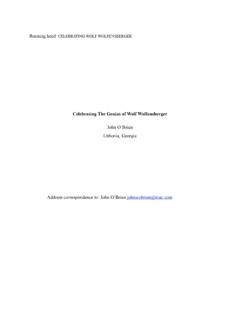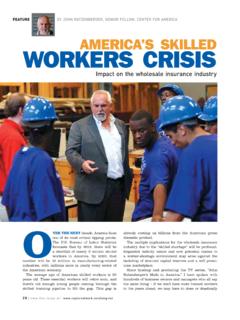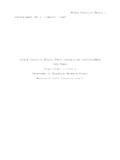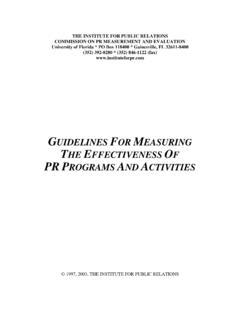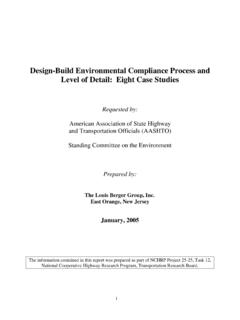Transcription of JOHN BERGER - Ways of Seeing
1 ' Seeing comes before words. The child looks and recognizes before it can speak. 'But there is also another sense in which Seeing comes before words. It is Seeing which establishes our place in the surrounding world; we explain that world with words, but words can never undo the fact that we are surrounded by it. The relation between what we see and what we know is never settled.'. john BERGER 's ways of Seeing is one of the most stimulating and the most influential books on art in any language. First published in 1972, it john BERGER . was based on the BBC television series about which the (London). Sunday Times critic commented: ~This is an eye-opener in more ways than one: by concentrating on how we look at paintings.
2 He will Seeing comes before words. The child looks almost certainly change the way you look at pictures.' By now he has. nizes before it can speak. But there is also another sense in which Seeing ' BERGER has the ability to cut right through the mystification of the before words. It is Seeing which establishes our place professional art critics .. He is a liberator of images: and once we have rrotmding world ; we explain that world with words, allowed the paintings ~o work on us directly, we are in a much better ;an never undo the fact that we are surrounded by position to make a meaningful evaluation' Peter Fuller, Arts Review relation between what we see and what we know is r settled.
3 ',The influence of the series and the book .. was enormous .. It opened up for general attention areas of cultural study that are now commonplace' Geoff Dyer in ways of Telling Published by the British Broadcasting Corporation and Penguin Books The front cover shows The Key of Dreams by Rene Magr~tte (photo Rudolph E~urckhardt). The Surrealist painter IV~agritte comntented UK U~A $ ~resent gap between words and Seeing in Seeing comes before words. The child looks and recognizes before it can speak. But there is also another sense in which Seeing comes before words. It is Seeing which establishes our place in the surrounding world; we explain that world with words, but words can never undo the fact that we are surrounded by it.
4 The relation between what we see and what we know is never settled. Each evening we see the sun set. We know that the earth is turning away from it. Yet the knowledge, the explanation, never quite fits the sight. The Surrealist painter Nlagritte commented on this always-present gap between words and Seeing in a painting called The Key of Dreams. notice how of touch is like a static, limited form of sight.) We never look at just one thing; we are always looking at ~e relation between things and ourselves. Our vision is continually active, continually moving, continually holding thiugs in a circle around itaalf, constituting what is present Soon after we can see, we are aware that we can also be seen.
5 The eye of the other combines with our own aye to make it fully credible that we are p~ of the visible world. ~f we ac~pp~ that we can see ~ha~ hil~ over there, we propose ~hat from that hiBI we can be seen. The reciprocal ~ature o~ vision is more fundamen~l than that of spoken ~ialogue. And often dialogue is an a~empt to verbalize this - an attempt to explain how, either metaphorically or literally, 'you see things', and an attempt to discover how "he sees ~hings'. in the sense in which we use the word in this book, a~l images are man-made. The way we see things is affected by what we kr~ow or what we believe. In the IVtlddle Ages when men believed in the physical existence of Hell the sight of fire must have meant something different from what it means today.
6 Naverthe|ass their idea of Hell owed a lot to the sight of fire consuming and the ashes remaining - as well as to their experience of the pain of burns. When in love, the sight of the beloved has a completeness which no words and no embrace can match : a completeness which only the act of making love can temporari|y accommodate. Vet this Seeing which comas before words, and can never be quite covered by them, is not a question of mechanically reacting to stimuli. (It can only be thought of in this way if one isolates the small part of the process which concerns the eye's retina.) We only see what we look at. To look is an act of choice.
7 As a result of this act, what we see is brought within our reach - though not necessarily within An image is a sight which has arm's reach. To touch something is to situate oneself in been recreated or reproduced, it is an appearance, or a set of relation to it. (Close your eyes, move round the room and appearances, which has been detached from the place and time Yet when an image is presented as a work of art, in which it first made its appearance and preserved - for a few moments or a few centuries. Every image embodies a way of the way people look at it is affected by a whole series of learnt assumptions about art. Assumptions concerning: Seeing .)
8 Even a photograph. For photographs are not, as is often assumed, a mechanical record. Every time we look at a photograph, we are aware, however slightly, of the Beauty photographer selecting that sight from an infinity of other Truth possible sights. This is true even in the most casual family Genius snapshot. The photographer's way of Seeing is reflected in his Civilization choice of subject. The painter's way of Seeing is reconstituted Form by the marks he makes on the canvas or paper. Yet, although Status ~. every image embodies a way of Seeing , our perception or Taste, etc. appreciation of an image depends also upon our own way of Many of these assumptions no longer accord with Seeing .
9 (it may be, for example, that Sheila is one figure among twenty; but for our own reasons she is the one we have eyes the world as it is. (The world-as-it-is is more than pure for.) objective fact, it includes consciousness.) Out of true with the present, these assumptions obscure the past. They mystify rather than clarify. The past is never there waiting to be discovered, to be recognized for exactly what it is. History always constitutes the relation between a present and its past. Consequently fear of the present leads to mystification of the Images were first made to conjure up the past. The past is not for living in; it is a well of conclusions appearances of something that was absent.
10 Gradually it from which we draw in order to act. Cultural mystification of became evident that an image could outlast what it '~he past entails a double loss. Works of art are made represented; it then showed how something or somebody had unnecessarily remote. And the past offers us fewer once looked ~ and thus by implication how the subject had conclusions to complete in action. once been seen by other people. Later still the specific vision When we "see" a landscape, we situate ourselves of the image-maker was also recognized as part of the record. in it. If we "saw' the art of the past, we would situate An image became a record of how X had seen Y.
